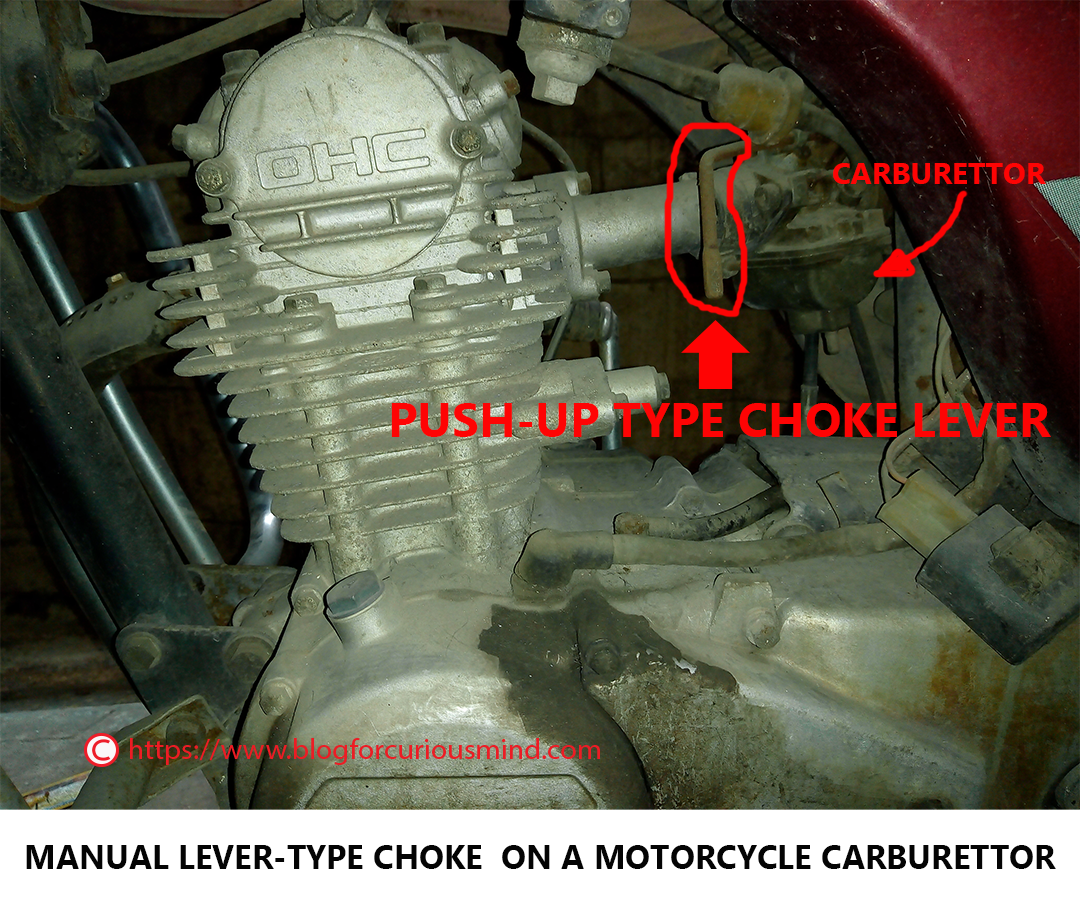Introduction
Most old-generation motorcycle riders have faced the problem of starting the engine on cold mornings. And the choke helped them on these occasions! So, what does a choke do on a motorcycle?
If you sense a bad smell while walking on a road, instinctively you block your nostrils. This will partially or completely block the entry of the bad smell into your nose. In other words, you are trying to choke your air passages to restrict the entry of bad smells.
What does the above example have to do with a motorcycle choke? Keep reading the article to know.
The choke is a common feature in automobiles that run on carbureted engines. Examples are motorcycles, scooters, and even cars.
This article takes you through the following subtopics:
- What does a choke do on a motorcycle and why is it required
- Do modern motorcycles with fuel-injection engines have a choke
- And a few frequently asked questions on the topic.
What does a choke do on a motorcycle and why is it required?
You can define a choke as a manually operated butterfly valve in a carbureted engine. Its function is to restrict/choke the amount of air entering the carburetor. Less air in the carburetor means an enriched fuel-air mix (more fuel and less air) entering the combustion chamber.
The choke is specifically used when starting the engine in cold conditions. A completely closed choke valve allows negligible air into the carburetor. Starting your motorcycle in the cold without a choke can be laborious.
We choke our air passage to restrict foul-smelling air entering the nostrils. In the same way, a motorcycle chokes the carburetor air passage to restrict air into the carburetor.
Chokes are butterfly valves at the venturi’s (carburetter) air filter side. They are typically found on automobiles with naturally aspirated carbureted engines. Furthermore, they supply an enriched fuel-air mix when starting an engine in cold conditions.
Closing the choke valve partially or fully restricts air into the carburetor. Consequently, more atomized fuel is sprayed into the carburetor venturi. So, the fuel-air mix becomes rich.
A manual choke is normally operated by pulling a knob conveniently placed near the motorcycle handle or pushing up a lever on the carburetor.
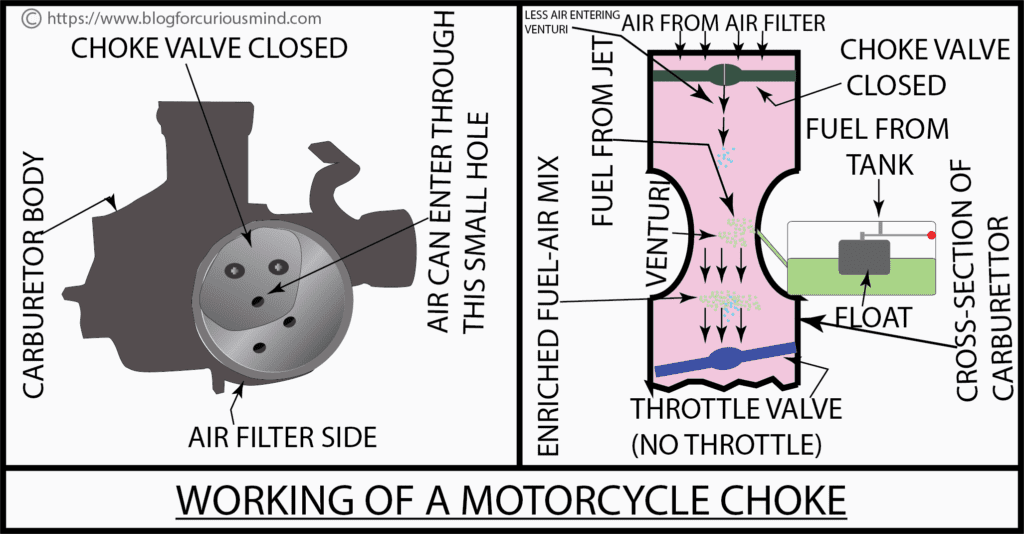
Once the engine reaches the operating temperature, the choke is taken off, and the correct proportion of the fuel-air mixture is controlled by the throttle valve and carburetor.
Some automobiles with a carbureted engine may have automated choke. Here, the choke is operated automatically by sensing the engine temperature. When you attempt to start the engine in cold conditions, the sensor senses the engine temperature and operates the choke.
The choke supplies an enriched fuel-air mix to the engine. When the engine reaches the operating temperature, the choke is taken off. The design of an automatic choke will be different from a manual choke.
Normally, a choke’s work is to restrict the flow of air. However, some chokes are designed to increase the fuel flow into the engine, instead of reducing the airflow. Both designs serve the purpose of enriching the fuel mix in the combustion chamber.
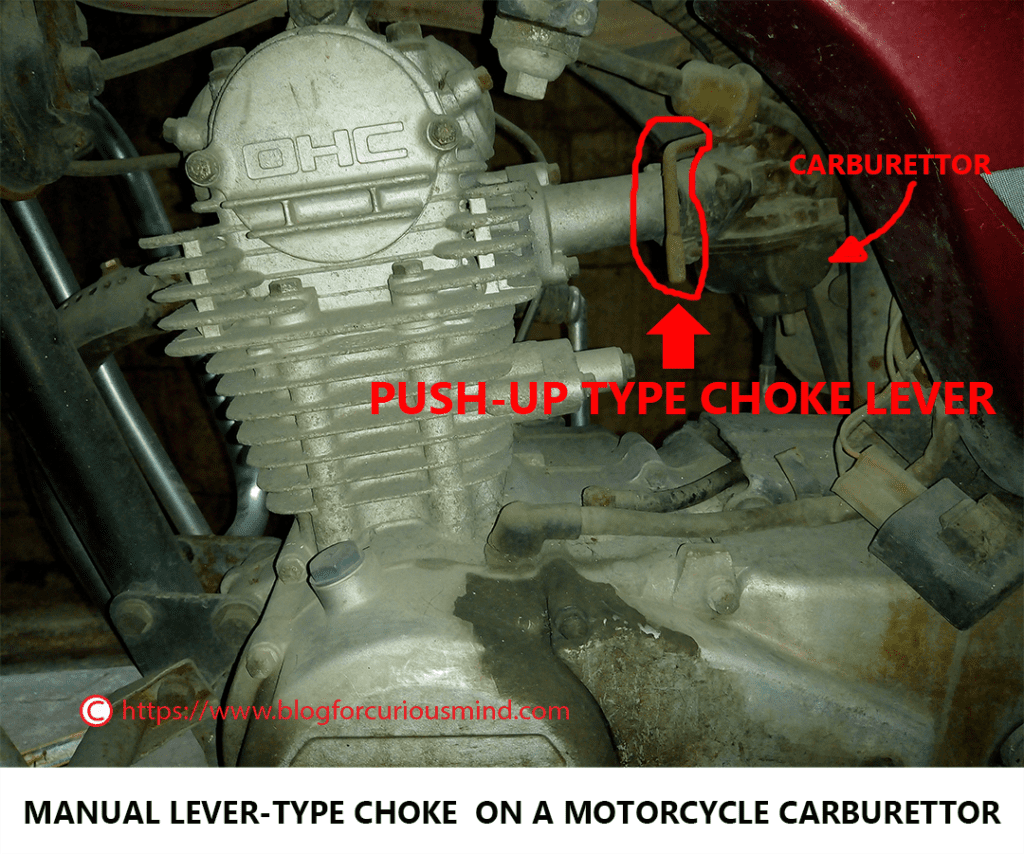
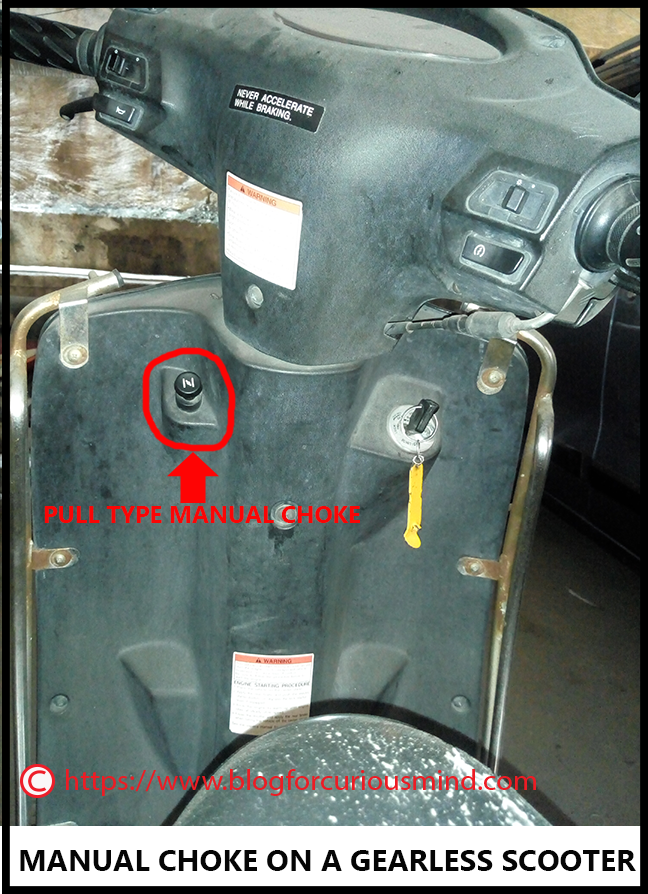
Before the introduction of fuel injection systems in automobiles, chokes were found in all automobiles including motorcycles. And, the chokes can be manual or automatic type. Even now chokes exist on equipment that uses carbureted engines. Examples are motorcycles, scooters, lawnmowers, marine engines, etc.
One frequently asked question is, if the choke closes the passage of air entry into the carburetor, how does combustion happen without air?
The answer is, the butterfly choke valve may have a small hole in the center to allow little air to be sucked in. Also, there will be one or two additional holes on the air filter side of the carburetor and a small quantity of air is sucked in by the idle circuit.
You may watch this YouTube video on how motorcycle choke works and this YouTube video on manual and auto chokes on motorcycles. The videos are in Hindi.
Do modern motorcycles with fuel-injection engines have a choke?
Motorcycles with an electronic fuel injection (EFI) system do not need a choke. The EFI system automatically ensures a supply of rich fuel-air mix for starting the engine in cold conditions.
Most modern medium—and high-end motorcycles have an EFI system instead of a carburetor. The EFI system has computer-like devices (ECU or engine control unit) and sensors to monitor the optimum fuel-air mix for different conditions, including starting a cold engine.
The sensor senses the temperature of the cold engine, and the ECU system recognizes the engine temperature and ensures an enriched fuel-air mix is supplied to the engine to help with easy starting.
Frequently Asked Questions (FAQ)
What is a motorcycle choke and why is it required?
A choke is a butterfly valve positioned on the air filter side of the carburetor. It is designed to choke (restrict) air entry into the carburetor resulting in a rich fuel-air mixture entering the engine’s combustion chamber. The rich fuel-air mix improves the cold engine’s starting ability.
How to operate a manual choke?
Most manual chokes are operated by pulling a knob that connects the choke valve through a cable or pushing up a lever on the carburetor.
Do not operate the throttle when the choke is on and remember to push it back to its original position after the engine attains operating temperature. Please look into your owner’s manual to know the position of the choke and how to use it.
What happens if I ride the motorcycle with the choke on?
If you ride your motorcycle with the choke in ‘on position’, the fuel consumption will be high. Additionally, the exhaust will be bluish (not good for the environment), and increase in deposits in the engine and exhaust. However, there will be no damage to the motorcycle engine.
Do cars have a choke valve?
Cars manufactured until the early 1970s had manual chokes since they ran on carbureted engines. Look into the dashboard of your father or grandfather’s old car, there will be a choke knob.
Later, the manual choke was replaced by the automatic choke. This continued till the 1990s when a fuel injection system was introduced to replace carburetors.
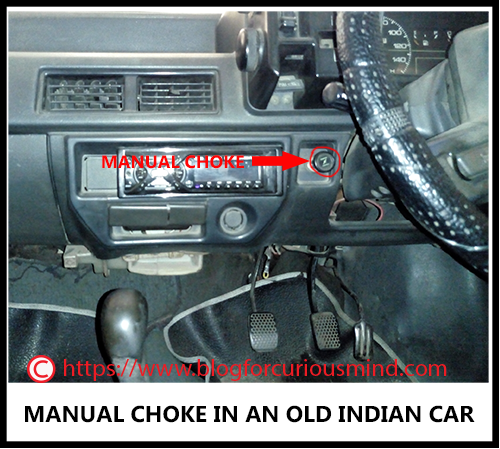
Most present-day cars have fuel injection systems and do not need a choke. The computer system in the engine gets the input of the engine temperature through a sensor and supplies an enriched fuel-air mix when the engine is cold.
You may read the following articles.
Why Two-stroke Engines were killed
Terms used in Motorcycle Specifications
Conclusion
We discussed the choke used in automobiles that run on carbureted engines in the above paragraphs. Hope this article was informative.

